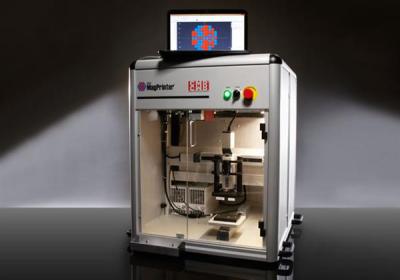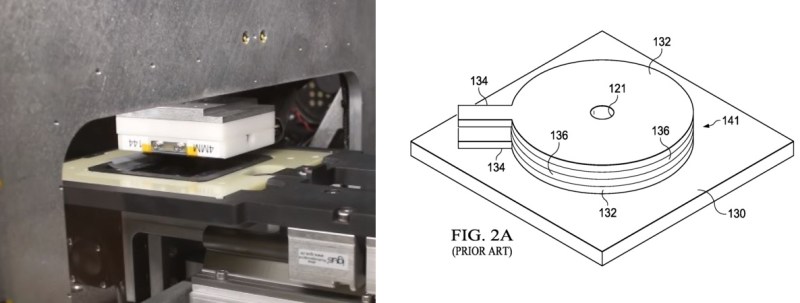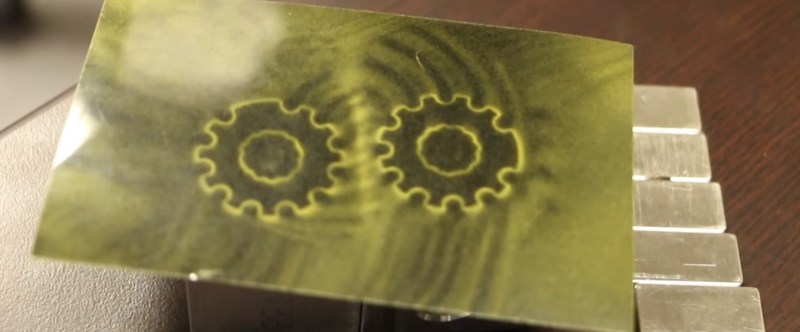We told you about these “printable” magnets a while back. When you have the ability to squeeze many smaller magnets into a tiny spot and adjust their north/south orientations at will, you can not only control the strength of the overall magnetic field, you can construct new and seemingly physics-defying widgets. This article will not focus on the magnets themselves, but instead we’re going to peel away the closed source shroud that hides the inner workings of that nifty little printer of theirs. There has been a lot of talk about these printable magnets, but very little about how they’re made. This changes today. We’ll show you how this magnetic field printer works so you can get busy making your own.
History
Several years ago, a company called Correlated Magnetic Research introduced to the world the idea of a magnetic field printer with the Mini MagPrinter. It sold for a whopping $45,000, which limited it to businesses and well-funded universities. They eventually changed their company to Polymagnet and now focus on making the magnets themselves. It appears, however, that they’ve refined their printer for a higher resolution. Skip to 2:45 in this video to see the Mini MagPrinter in action. Now skip to 7.25 in this video to see their next generation printer. Now lets figure out how they work.
What We Know

Firstly, you can toss your Kickstarter idea in the recycle bin because they hold several patents for their printer. But that doesn’t mean you can’t make one in your garage or for your hackerspace. Their machine might have cost $45k, but we’d be willing to bet a dozen Raspberry Pi Zeros that you could make one for two orders of magnitude less. But first we need to know how it works. Let’s look at the science first.
The Curie Point
The Curie Point is a temperature where a magnet loses its magnetic field. It is theorized that magnetism arises from the spin and angular momentum of electrons. If you get them lined up correctly, you get a magnet. When you heat the metal past the Curie Point, this alignment gets all messed up and you lose the magnetic properties. And, of course, you can align the atoms back up by introducing the metal to a strong magnetic field.
Halbach Array
A Halbach array is created when smaller magnets are arranged so their magnetic fields are focused in a particular direction and cancel out in another direction. The magnets made by the magnetic field printer can be considered Halbach arrays.
How It Works
Everything begins with a blank Neodymium magnet. We’re all familiar with CNC technology, so we’ll focus on the magnetic field printing head itself. Reading through the comments of the original article, many believe that it uses a combination of heating to exceed the Curie Point and a high strength electromagnet to “write” the magnetic field into the blank. However, after looking closely at this patent, it appears this is not the case. There is no heating involved. The printer head consists of “an inductor coil having multiple layers and a hole extending through the multiple layers” and works by “emitting from the inductor coil a magnetic field that magnetizes an area on a surface of the magnetizable material…”. In short, it’s just a strong, local magnetic field.

Make Your Own
Now that you have a basic idea of how to print magnetic fields, you can start working on one of your own design. You already know how to make 3d printers and laser cutters. Just take one of these designs and replace the head with your custom-built magnetic printer head, whip up some software and bring this technology into the open source community. Blank Neodymium magnets and magnetic field viewing film are fairly cheap. First one to print the skull and wrenches logo gets a free t-shirt!
















Just theorizing here, but just because there is no “heater” referenced, doesn’t mean no heating happens. Could eddy currents in the magnet cause heating to the curie point? Maybe thats part of the secret of achieving this
Interesting point.
For some reason, I always thought rare earth magnets were magnetized at the factory by heating them past the Curie point, then cooled in the presence of a field to “lock in” that field. And that may be one way of doing it, but…
After a little Googling, I find no reference to this in several manufacturer’s description of their process. Only that a brief and intense magnetic pulse is applied, which must be at least 3x the magnet’s coercivity (Hci).
Which seems consistent with what the linked patent is describing.
It would be interesting to see if heating past the Curie point and cooling in a field would work. That suggests the idea of using a “print head” which consists of a solenoid with a hollow bore, down which is fired a laser to heat the magnet surface at a point. Printing would consist of energizing the solenoid, firing the laser, then moving to the next point.
Speed might be an issue: can the magnet heat and cool fast enough while locking in the field to do the trick?
You are describing a magneto-optical disk head
Anyone in Austin TX want to try and prototype one of these? It could be pretty cool to have one at a local hackerspace, although I am not a member at any :(
I saw one of these machines at the san fran tech-shop. could not think of a good use for it, but was impressed they had such a machine. I got the impression it was a demo by the vendor, meant to showcase it and advertise it.
If you think about it a wee bit longer you can realize that heating will not work, if you need any decent resolution. You cannot heat up a point in isolation. You will mess up surrounding “pixels” while you are heating the current one.
Ah, good point. Hadn’t thought about that
On these devices, the pixel size also varies based on the strength of the magnetic pulse that you use.
Laser?
Oh, you can, that’s how magneto-optical storage works. Early tech from before CD-RW. Basically the same thing we’re discussing, a magnetic disk a lot like a CD, except it can only be magnetised when heated. A laser heats a teeny wee spot, while a much larger, coarser electromagnet provides the field. Only the spot heated by the laser takes on the field. They got a few hundred MB on something the size of a CD. Dunno if the technology’s advanced since then, or if phase-change technology took over.
It’s read in the normal way, with a coil, the laser is only for writing.
Actually… Just wondering if you could re-program an old magneto-optical drive, in a Lightscribe-like way, to produce a graphical magnetic image on an MO disk. Would piss these guys off a bit! Ssssh, nobody tell the Patent Office.
Greenaum, the amount of magnetic fields are vastly different for these two different applications. You cannot make a magnet out of that media.
Also those magneto optical drives are not using coils to read, they measure the change in the reflected light. Hence the name.
Magnetic “printing” is really the wrong term for this. It doesn’t put any material down on the surface.
Magnetic “programming” would be a far better term.
This also works on ceramic magnets (but you have to use _much_ lower power and the result is limited in strength, but it’s a cheap way to experiment)
I have used this equipment,
The idea of 2D printing is not to put material on the paper, but it is the method used. How about heat printing? It does not put any material on the surface either.Just a thought.
But this is not putting something on a blank slate, it’s overriding what’s there with a new setting.
you don’t have to start with blank magnets, it works great just putting S pole dots on the N pole of the magnet, and you can re-write the surface of the magnet.
but yes, I am picking nits here :-)
But when I heard about a ‘magnet printing class’ I envisioned either putting magnet material on some other surface, or printing signs on sheets of magnets. overriding the polarity of the magnet in tiny spots wasn’t remotely close to what I was thinking.
Then printing on thermal fax paper isn’t printing. It’s thermochemical programming?
Drawing a bird on your magnadoodle, son?
No dad, I am programming a bird.
The credit for this should go to the inventor of magnetic tape recording as used in video tape and hard disc drives since they print magnetic patterns on fero-magnetic materials. Would any body like to use a simple magnet to write fields on a say, hard disc drive platter ?
Yeah this is just the same thing as a magnetic tape or HD write head it appears, but as for the invention, didn’t they start with recording to a wire?
Checked and confirmed it seems: https://en.wikipedia.org/wiki/Magnetic_recording#History
You can use a laser to heat locally. The material reflects most of the light, but the part that is absorbed turns into heat, which will be conducted away with a rate that depends on the material. If you send more energy than the material can dissipate, that energy will increase the temperature locally, for a very small period of time. Maybe the material is able to align with an external magnetic field in that period, recording the field locally when the heat is dissipated. All depends on some physical parameters that are known for those magnets.
I’ve read somewhere back in the early 90’s that the Curie Point is a temperature range that resembles a notch filter. If the magnet is heated through and beyond this range of temperatures, it once again becomes a magnet. I never got around to trying it, but I tucked it away in the back of my mind for a future project.
Never heard this story. But perhaps you should not heat the magnet much higher, as the crystal structure or chemical composition of the material could change in an unwanted, irreversible way.
Heh.
Talking about magnetic field viewing film and about HDD or magnetic tape: i’ve always wondered if it could be possible to “digitize” the magnetization pattern of a recording media surface (for instance a tape or an hard or floppy disk) without using the original reader or knowing how it has been recorded (linear or helican scan, analog or digital…) in order to later “decode” its content by software, like a “Software Defined Tape or Disk Reader”. What do you think?
Actually, neodymium magnets are made by placing the blank magnet inside a coil which produces an intense magnetic field to overcome the coercitivity of neodymium.
That is why I would say that heating is not a good idea since it implies you would let 10s of kA for at least a few seconds.
Also you can arrange your coils in a particular way to produce a highly directive magnetic field, this may be what is going on here…
here is a video of reproducing polymagnets at home https://www.youtube.com/watch?v=MOWZc8UUs5E
There is a video showing someone reproducing the effect at home, search #1:Successful Replication of “Polymagnets” At Home, The DYI CMR “programed” magnets on youtube
Maybe it’s just me, but it kinda seems like there’s something of a rather large knowledge gap between the “how it works” paragraph, and the “make your own” paragraph. Just having a “general idea” of how something works is quite far removed from knowledge that is concrete enough to know how to actually implement something. The patent is encumbered by terminology that, although quite common in patent descriptions, only seems to obfuscate how such a device might be built unless one has a considerable amount of experience reading patents and understanding them. While the patent would still be undoubtedly helpful, a layman’s explanation accompanying it, detailing many of its main points in more everyday terminology such as what this article otherwise uses, would be much more helpful.
Anyone in the Greater NYC area want to discuss and work on this?
Check it. A guy reverse engineered it
https://youtu.be/MOWZc8UUs5E